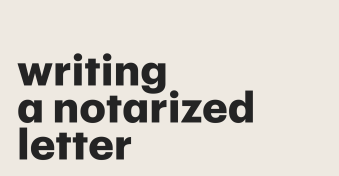An error on your credit report can have significant consequences for your personal finances and business, impacting your ability to take out a loan in the future.
That’s why being able to dispute credit reports is so important, and this requires sending a credit dispute letter.
In this guide, we explain everything you need to know about dispute letters and provide a template to help you draft your own.
Key takeaways:
- A credit dispute letter notifies finance agencies of an error on a credit report.
- You can use them to rectify mistakes such as inaccurate payment records.
- These letters should include personal information, dispute details, and a copy of the report.
- You can use a credit dispute letter template to simplify the drafting process.
What is a credit dispute letter?
Imagine you’ve just received your credit report.
Suddenly, you see that your credit rating has plummeted. With your financial future in flux, you scan up and down for an explanation.
When you spot a mistake, you breathe a sigh of relief — it’s only an error.
But how can you make sure your credit bureau rectifies their mistake? A credit dispute letter is needed.
This should flag any errors you’ve noted and also include a completed dispute form (accessed from the bureau’s website).
Following the Fair Credit Reporting Act, the right to dispute is protected under federal law.
This means that sending a dispute letter is free, and all bureaus must respond upon receiving these.
What types of errors can you dispute on a credit report?
So, what type of errors can you dispute on a credit report?
Wrong payment details
Some of the most common credit report errors are based on incorrect payment details.
This might be due to a faulty document management process by a bank or credit bureau, meaning payments are wrongly seen as late or missed.
Inaccurate bank balances
Similarly, a lot of credit rating mistakes are due to the bureau not receiving information about changes to your bank balance or credit limit.
If you’ve reached the upper bound of a previous credit limit, for instance, a bureau might interpret this negatively if they don’t know your limit has increased.
Erroneous account details
Sometimes, former spouses or business partners continue to be linked to your credit report even when they’ve stopped living or working with you.
This can lead to your account being wrongly linked with their financial activities.
How to write a credit dispute letter (information to include)
Once you’ve spotted a mistake on your credit report, it’s natural to want this resolved as soon as possible.
However, the actual process of writing a dispute letter can be challenging if you’ve not done it before.
To help you, here’s a checklist of information to include in your letter.
Your personal information
Credit bureaus deal with tens of thousands of customers, so you should include as much personal information as possible to prevent any delays in resolution.
Your letter should detail your full name and date of birth, as well as your address and social security number.
You also want to include the relevant account number.
Information about the dispute
As well as making sure you’ve included all applicable personal data, you should include everything related to the dispute.
This will mean there’s less chance of the bureau contacting you for additional information.
This sort of info should include detailed descriptions of the dispute and an explanation about why you think it’s an error, as well as factual information such as dates and account numbers.
Copies of the report
It’s also important that the bureau is able to see your credit report. Create photocopies of this and enclose them with the letter.
If you’re sending this via email, you might want to make use of a tracking documents feature so you know when the bureau has accessed these copies.
A credit dispute letter template
Now you know what to incorporate in your credit report dispute letter, you might be wondering what exactly this should look like. Here’s a sample you can draw from.
[Your full name]
[Your account name/number]
[Your date of birth]
[Social security number/license number]
[Your current address]
[Your telephone number and other contact details]
[Current date]
[Name of the relevant credit bureau]
[Credit bureau’s address]
Re: Dispute of error/errors on credit report
Dear [bureau name],
I am writing to inform you of an error/errors on my credit report (dated MM-DD-YY) and to request a correction. Please find a list of the incorrect parts of the report, with an explanation of these errors, below.
[Include a list of errors and explain why each is incorrect]
I have attached a copy of my report where you can see the errors as they are featured in it.
[Attach a copy of the report, alongside copies of any other relevant documentation]
Thank you for your assistance and your speedy resolution of this matter,
Sincerely,
[Your name]
An overview of the dispute process
While you’ll probably need to send a dispute letter regardless of the credit agency you use, the specific elements of the dispute process differ between the major bureaus.
This shouldn’t come as a surprise—just think about the different online systems, security policies, and credit regulations each bureau has.
To help you, we’ve outlined the processes of three major credit bureaus below.
Equifax
If you receive your credit report from Equifax, you should head over to their website to begin your dispute.
You’ll find a section entitled ‘Dispute information on your Equifax credit report’.
This webpage includes a link to a specific portal that’s built for disputes.
You’ll have to fill in a lot of the same information you’ve already collected for your dispute letter; however, some of this might be saved if you’ve already created an account.
The next part of the Equifax dispute process involves uploading the relevant documents.
They suggest that driver’s licenses, current bank statements, and student loan letters can be helpful.
Once you’ve uploaded your dispute, you’ll receive a code you can use to check on its status.
Equifax promises to resolve the error within 30 days, after which your credit report will be updated.
Experian
Experian credit reports can be disputed via a traditional dispute letter or by filling out an online dispute form.
While both methods are effective, Experian says they’ll be able to resolve your issues more quickly if you file the dispute virtually.
If you choose to log your dispute online, you’ll have to find the section on Experian’s website called the ‘Experian Dispute Center’.
This will prompt you to enter relevant personal details as well as information about your dispute.
While this approach is useful if you’re looking at reducing paper usage, you can also still send a dispute letter through the mail.
You just have to send your completed letter (as well as any copies of supporting documents) to P.O. Box 4500, Allen, TX 75013.
Regardless of whether you’ve filed your dispute online or through the mail, Experian will resolve it in 30 days. You’ll be notified when the results come in, and your credit score will update.
TransUnion
Just like Equifax and Experian, TransUnion has a dedicated online portal for receiving disputes.
However, you can also send a letter through the mail. To do this, you should send it to TransUnion Consumer Solutions, P.O. Box 2000, Chester, PA 19016-2000.
If you choose to file your dispute through the online portal, simply head to the section of the TransUnion website called ‘TransUnion Service Center’ and choose ‘Dispute’.
From here, you can upload your personal details and account information, as well as your supporting documents.
TransUnion promises to investigate the dispute within 30 days of receiving it.
They’ll then send you a summary of their results and a revised version of the initial credit report, which has been updated to remove any errors.
Safeguard your score by creating credit dispute letters that work
Disputing an erroneous credit report is necessary, but it can also be hard work.
While you can opt to use online portals, a dispute letter template is also a great way to save time.
To make disputing a credit report even more of a breeze, take advantage of PandaDoc’s document management software.
This will allow you to save and edit letter templates for future use.
Leaving your credit score to chance is never a good idea, so it’s crucial you can be confident in your credit dispute letters and their ability to get results.
Frequently asked questions
-
You don’t have to send a letter to dispute a credit report. The three major credit agencies all have online dispute portals, and it’s possible to file a dispute over the phone too.
-
In most cases, even an unsuccessful dispute is unlikely to affect your credit score. However, some failed reports can impact this, so always check the details before filing a report.
-
All three of the major agencies discussed above promise to resolve your dispute within 30 days.
Disclaimer
PandaDoc is not a law firm, or a substitute for an attorney or law firm. This page is not intended to and does not provide legal advice. Should you have legal questions on the validity of e-signatures or digital signatures and the enforceability thereof, please consult with an attorney or law firm. Use of PandaDocs services are governed by our Terms of Use and Privacy Policy.


